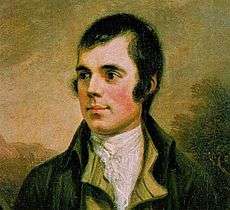Comin' Thro' the Rye
"Comin' Thro' the Rye" is a poem written in 1782 by Robert Burns (1759–96). It is well known as a traditional children's song, with the words put to the melody of the Scottish Minstrel Common' Frae The Town. This is a variant of the tune to which Auld Lang Syne is usually sung—the melodic shape is almost identical, the difference lying in the tempo and rhythm.
G. W. Napier, in an 1876 Notes and Queries, wrote that,
The original words of "Comin' thro' the rye" cannot be satisfactorily traced. There are many different versions of the song. The version which is now to be found in the Works of Burns is the one given in Johnson's Museum, which passed through the hands of Burns; but the song itself, in some form or other, was known long before Burns.[1]
The protagonist, "Jenny", is not further identified, but there has been reference to a "Jenny from Dalry" and a longstanding legend in the town of Dalry, North Ayrshire, holds that "comin thro' the rye" describes crossing a ford through the Rye Water at Drakemyre to the north of the town, downstream from Ryefield House and not far from the confluence of the Rye with the River Garnock.[2][3] When this story appeared in the Glasgow Herald in 1867, it was soon disputed with the assertion that everyone understood the rye to be a field of rye, wet with dew.[4] An alternative suggestion is that "the rye" was a long narrow cobblestone paved lane, prone to puddles of water.[2]
While the original poem is already full of sexual imagery, an alternative version makes this more explicit. It has a different chorus, referring to a phallic "staun o' staunin' graith" (roughly "an erection of astonishing size"), "kiss" is replaced by "fuck", and Jenny's "thing" in stanza four is identified as her "cunt".[5][6][7]
Lyrics
 |
Comin' Thro' the Rye
Tune for Comin' Thro' the Rye |
| Problems playing this file? See media help. | |
O, Jenny's a' weet,[A] poor body,
Jenny's seldom dry:
She draigl't[B] a' her petticoatie,
Comin thro' the rye!
Chorus:
Comin thro' the rye, poor body,
Comin thro' the rye,
She draigl't a' her petticoatie,
Comin thro' the rye!
Gin[C] a body meet a body
Comin thro' the rye,
Gin a body kiss a body,
Need a body cry?[D]
(chorus)
Gin a body meet a body
Comin thro' the glen
Gin a body kiss a body,
Need the warl'[E] ken?[F]
(chorus)
Gin a body meet a body
Comin thro' the grain;
Gin a body kiss a body,
The thing's a body's ain.[G]
(chorus)
Ilka lassie has her laddie,
Nane, they say, ha’e I
Yet all the lads they smile on me,
When comin' thro' the rye.
- A weet – wet
- B draigl't – draggled
- C gin – if, should
- D cry – call out [for help]
- E warl – world
- F ken – know
- G ain – own
The Catcher in the Rye
The title of the novel The Catcher in the Rye (1951) by J. D. Salinger comes from the poem's name. Holden Caulfield, the protagonist, misinterprets a part of this poem to mean "if a body catch a body" rather than "if a body meet a body." He keeps picturing children playing in a field of rye near the edge of a cliff, and him catching them when they start to fall off.[8]
Cover versions
- The song was covered by Marian Anderson in 1944
- The song was covered by Bill Haley & His Comets in 1956 as ‘Rockin' Through The Rye’. Bill Haley had updated the lyrics to a more 1950's hip slang (included the lyrics, "All the lassies rock with me when rockin' through the rye"). In Sept 1956, when the record was climbing the UK charts, the single was banned by the BBC from its playlist because they felt the song went against traditional British standards. Nevertheless, the record was at No. 5 on the UK charts.
- The song was covered by Alvin and the Chipmunks for their 1960 album Around the World with The Chipmunks.
- The song was covered by The Real McKenzies for their 2005 album "10,000 Shots."
- The song was covered by Ava Gardner in the 1953 John Ford film "Mogambo." [9]
- The song was parodied by Allan Sherman on his 1963 album My Son, the Celebrity.
- The song was covered by Julie London on her 1959 album, "Swing Me an Old Song."
References
- ↑ Napier, G. W. (19 February 1876). Notes and Queries (112) https://books.google.com/books?id=PEwAAAAAYAAJ&pg=PA151#v=onepage&q&f=false. Missing or empty
|title=(help) - 1 2 John Cairney (1 January 2011). The Luath Burns Companion. Luath Press Ltd. p. 267. ISBN 978-1-906817-85-5.
- ↑ Sheila Douglas (January 1996). "Burns and the Folksinger". Burns Conference, Strathclyde University. STELLA. Retrieved 2014-10-28.
- ↑ Robert Burns (1871). The complete poetical works of Robert Burns, arranged in the order of their earliest publication: (With New Annotations, Biographical Notices &c., by Scott Douglas). James M'Kie. p. 11.
- ↑ Damrosch, David (2003). What is world literature?. Princeton University Press. p. 123.
- ↑ "Comin' thro' the rye [alternate version]". BBC. Retrieved 30 November 2011.
- ↑ Burns, Roberts (1911). The Merry Muses of Caledonia. p. 61.
- ↑ Chen, Lingdi (May 2009). "An Analysis of the Adolescent Problems in The Catcher in the Rye". Asian Social Science. 5 (5): 144. doi:10.5539/ass.v5n5p143. Retrieved 2 November 2011.
- ↑ 1
External links
- Digitised copy of Comin' thro' the rye in James Johnson's Scots Musical Museum pp. 430–431, "Written for this Work by Robert Burns", printed between 1787 and 1803. Published online by National Library of Scotland. JPEG, PDF, XML versions.
- Public domain recording (1914) by Alma Gluck
